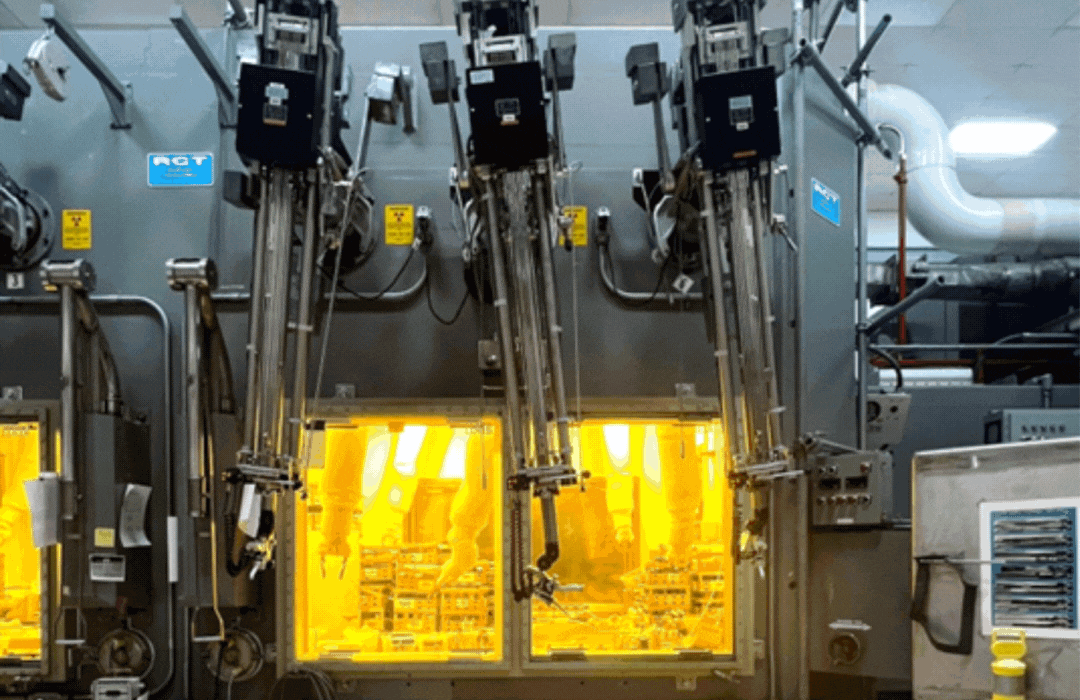Upgrades are under way to prepare the 222-S Laboratory for the next evolution in the Hanford Site cleanup mission, treating tank waste under the Direct-Feed Low-Activity Waste Program.
Office of Environmental Management
March 26, 2024
This series of photos highlights work to replace original oil-filled “hot cell” shielded windows at the Hanford Site’s 222-S Laboratory, as shown in the first photo. In the second photo, crews wear protective equipment and work in radiation containment tents while they replace the hot cell windows. In the third frame, old window glass is removed, wrapped and ready for disposal. The final photo provides a view of the new windows installed in the hot cells.
This series of photos highlights work to replace original oil-filled “hot cell” shielded windows at the Hanford Site’s 222-S Laboratory, as shown in the first photo. In the second photo, crews wear protective equipment and work in radiation containment tents while they replace the hot cell windows. In the third frame, old window glass is removed, wrapped and ready for disposal. The final photo provides a view of the new windows installed in the hot cells.
RICHLAND, Wash. — Upgrades are under way to prepare the 222-S Laboratory for the next evolution in the Hanford Site cleanup mission, treating tank waste under the Direct-Feed Low-Activity Waste (DFLAW) Program.
Operated by contractor Navarro-ATL, it’s the primary onsite lab for analyzing radioactive samples to support Hanford’s risk-reduction and tank-waste operations.
“Multiple contractors and facilities are working as a single enterprise to prepare for treating tank waste 24/7 and progressing risk-reduction projects,” said Delmar Noyes, EM assistant manager for Tank Waste Operations. “Our One Hanford team remains committed to delivering strong taxpayer value by advancing projects that reduce risks to our workforce, our community and the environment.”
The lab was built in the 1950s to support plutonium production and was converted to a high-level waste laboratory in the 1990s, following the Cold War.
Navarro-ATL is upgrading radiation containment rooms called “hot cells” that protect lab personnel while they receive and analyze radioactive waste samples. Navarro-ATL analyzes air, liquid, soil, sludge and biological samples at the lab.
The word “hot” refers to radioactivity. The “cells” are square enclosures with thick walls. Workers look through leaded glass windows with multiple layers of glass, some as thick as five inches, while they use manipulators to handle samples and equipment. The glass layers create a “sandwich” with mineral oil in the middle that clarifies the view inside.
Some of the widows began leaking oil due to their age, requiring an upgrade. The contractor has been replacing the windows in hot cells with new non-oil-filled windows that have an extended life of approximately 20 years. So far, they have replaced four of the 10 heavy windows.
Since the hot cells contain radiation, it’s no small feat to remove multiple windows weighing approximately 11,000 pounds from a contaminated area, disassemble the windows, and maneuver them through a confined pathway for removal. The team rolled in window replacements, placed them in a containment tent and lifted them into place.
“Safely replacing the hot cell windows is an important project for the laboratory to maintain mission support,” said Will Pickett, laboratory projects director. “We also balance this work with analytical priorities in the same facility, because samples are being received while this project is underway.”
In preparation for the window replacement, Navarro-ATL used multiple tools to analyze the hazards, including worker feedback. The contractor did mock-up demonstrations with the window vendor and proficiency demonstrations.
The contractor will continue replacing hot cell windows at the 222-S Laboratory through the summer.
-Contributor: Tracie Arnold
To receive the latest news and updates about the Office of Environment Management, submit your e-mail address.

